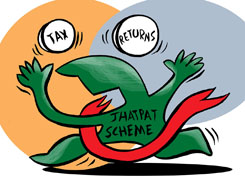Mihir Tanna |1070 Answers |Ask -Follow
Tax Expert - Answered on Sep 07, 2022
He handles various kinds of matters related to direct tax such as PAN/ TAN application; compliance including ITR, TDS return filing; issuance/ filing of statutory forms like Form 15CB, Form 61A, etc; application u/s 10(46); application for condonation of delay; application for lower/ nil TDS certificate; transfer pricing and study report; advisory/ opinion on direct tax matters; handling various income-tax notices; compounding application on show cause for TDS default; verification of books for TDS/ TCS/ equalisation levy compliance; application for pending income-tax demand and refund; charitable trust taxation and compliance; income-tax scrutiny and CIT(A) for all types of taxpayers including individuals, firms, LLPs, corporates, trusts, non-resident individuals and companies.
He regularly represents clients before the income tax authorities including the commissioner of income tax (appeal).... more

I have a problem with regard to IT payment for myself as a salaried individual for assessment year 2021-22. I had delayed my payment, but was able to pay it within the designated time. I was further asked to pay an amount of around Rs 4,341 by 31st March. However I had some issues with the transaction password on my online bank account, and thus missed the deadline. The amount is still unpaid. What should I do?
In case income tax demand is not paid within 30 days of its generation, interest of 1% p.m. will be levied u/s 220 of Income Tax Act. So pay tax online through e-filing website or directly from the bank website.
You may like to see similar questions and answers below
Mihir Tanna |1070 Answers |Ask -Follow
Tax Expert - Answered on Sep 29, 2022

- I understand you are using online feature of filing Income Tax Return at www.incometax.gov.in wherein data is prefilled based on information reported by different persons (like employer for salary, bank for interest income, company for dividend income, TDS deductor for TDS deducted and amount of income credited, etc.). In your case, it might be possible that reportable entity has revised its data for reporting to income tax department and accordingly amount appearing in intimation issued u/s 143(1) differs from amount auto populated while filing income tax return u/s 139(5) of Income Tax Act using online feature.
- It is not advisable to restrict auto populated income unless income auto populated at e-filing portal is incorrect. Check AIS for income auto populated at e-filing portal. If income appearing in AIS is incorrect, you can file feedback for AIS and offer actual income to tax while filing return u/s 139(5) of the act which allow tax payer to revise return by rectifying mistakes.
- Yes, income tax provides updated figure at portal even if intimation is issued u/s 143(1) of the Act, as revised figures is provided by the payer of income or person authorised as reportable entity.
- I understand you are talking about self-assessment tax paid by you and not auto populated in relevant schedule of ITR. Reason for the same can be wrong selection of year or code while making payment or while uploading challan details by the bank. Please check 26AS for self-assessment tax paid, if the same is not appearing in 26AS of AY 2022-23, you have to discuss said issue with Jurisdictional officer.
Mihir Tanna |1070 Answers |Ask -Follow
Tax Expert - Answered on Nov 02, 2022
Tejas Chokshi | Answer |Ask -Follow
Tax Expert - Answered on Sep 11, 2023
Nayagam P P |10303 Answers |Ask -Follow
Career Counsellor - Answered on Aug 15, 2025
Nayagam P P |10303 Answers |Ask -Follow
Career Counsellor - Answered on Aug 15, 2025
Nayagam P P |10303 Answers |Ask -Follow
Career Counsellor - Answered on Aug 15, 2025
Nayagam P P |10303 Answers |Ask -Follow
Career Counsellor - Answered on Aug 15, 2025
Nayagam P P |10303 Answers |Ask -Follow
Career Counsellor - Answered on Aug 15, 2025
Nayagam P P |10303 Answers |Ask -Follow
Career Counsellor - Answered on Aug 15, 2025
Nayagam P P |10303 Answers |Ask -Follow
Career Counsellor - Answered on Aug 15, 2025
Nayagam P P |10303 Answers |Ask -Follow
Career Counsellor - Answered on Aug 15, 2025
Nayagam P P |10303 Answers |Ask -Follow
Career Counsellor - Answered on Aug 15, 2025
Nayagam P P |10303 Answers |Ask -Follow
Career Counsellor - Answered on Aug 15, 2025















